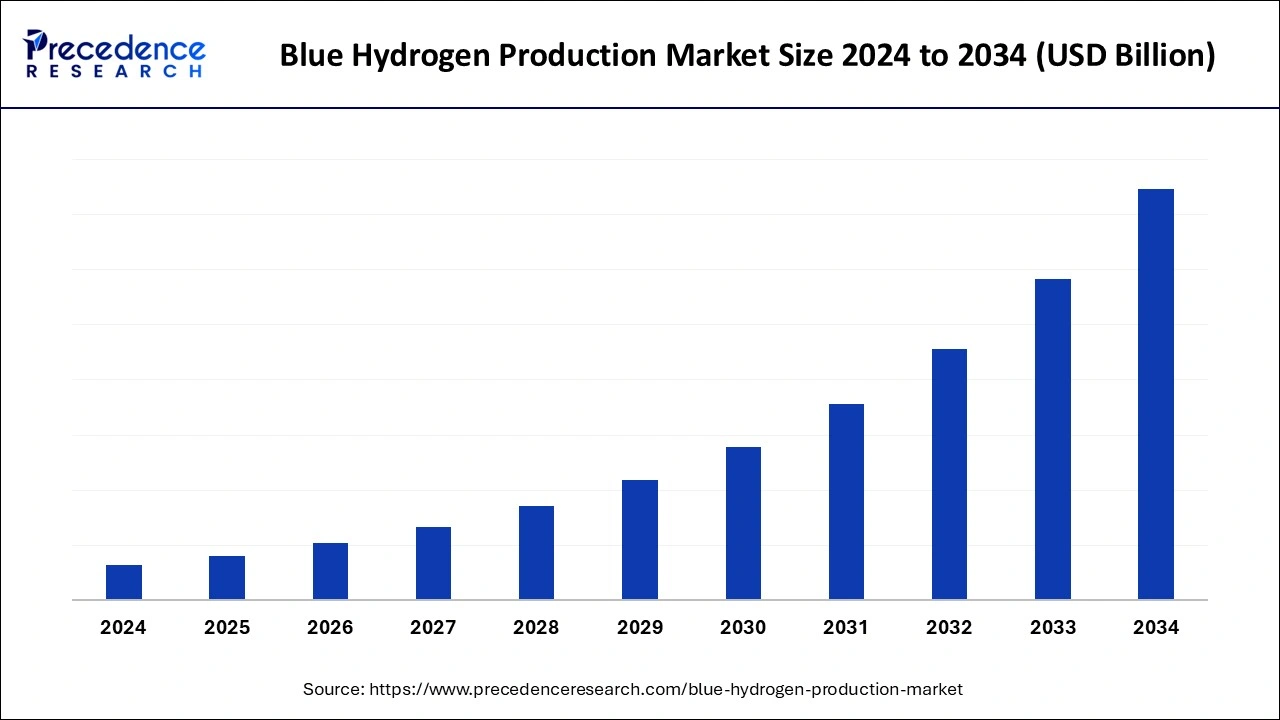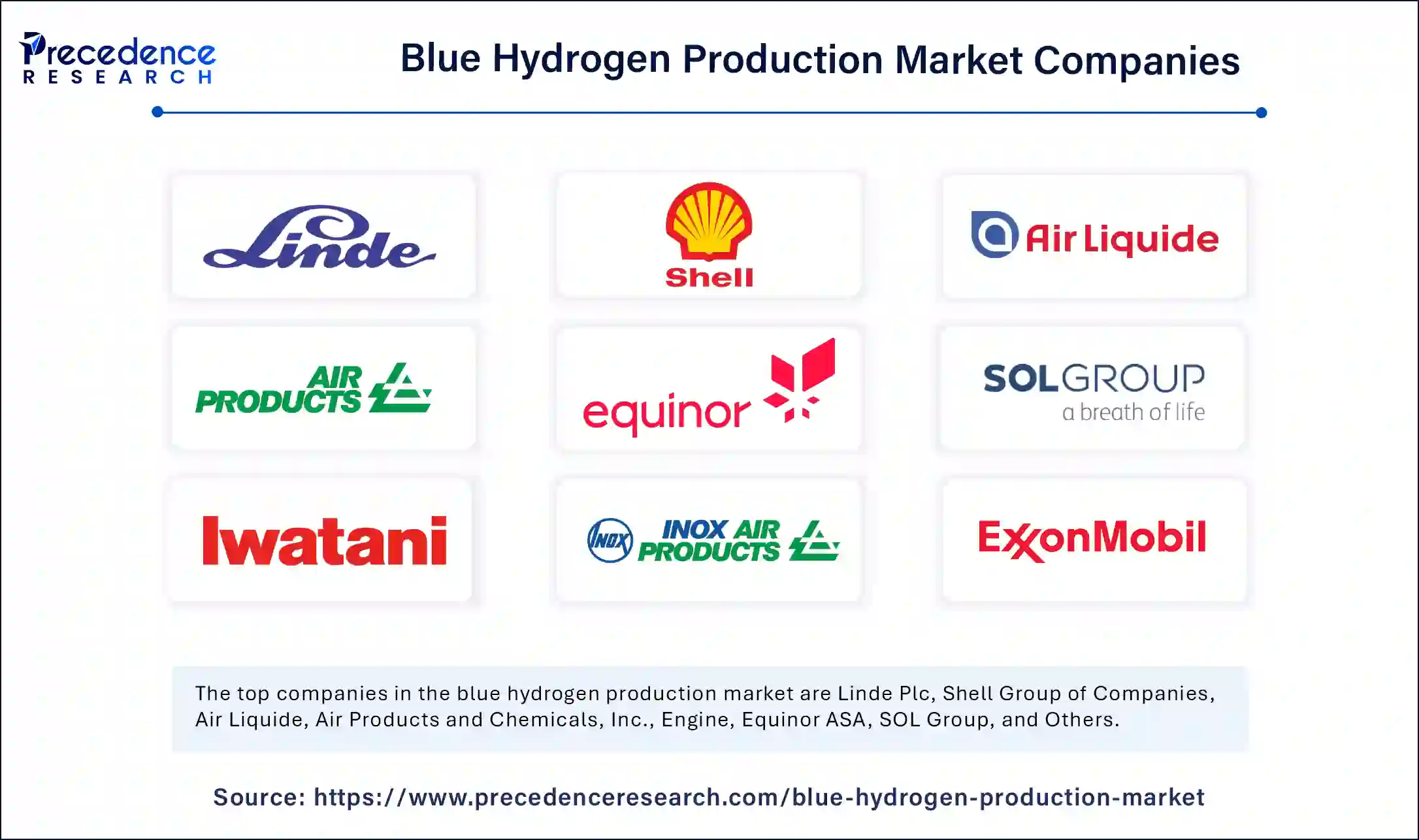September 2024
The worldwide blue hydrogen production market is forecasted to grow at a solid CAGR between 2025 and 2034. The market sizing and forecasts are revenue-based (USD Million/Billion), with 2024 as the base year.
The global blue hydrogen production market will expect to see extraordinary compound annual growth rate (CAGR) over the next decade. The blue hydrogen production market is driven by increasing government incentives, rising demand for clean energy, and technological advancements in carbon capture and storage.

The development of the blue hydrogen production market relies gradually on the implementation of artificial intelligence. Artificial intelligence optimizes the power grid integration of renewable energy resources like solar and wind systems, and advanced algorithms function to forecast renewable power output while managing real-time grid consumption. AI provides essential tools to manage demand alongside consumption prediction capabilities that support the balance between energy supply and demand and grid stabilization.
AI allows the implementation of predictive maintenance through machine learning algorithms that detect equipment failure before it happens, thus decreasing operational time and cutting repair expenses. The smart grid technology allows AI to synchronize energy generator operations with consumer requirements and store energy installations.
Blue hydrogen production from fossil fuels by capturing and storing carbon emissions has become a leading solution for clean energy generation. The production of blue hydrogen through steam methane reforming (SMR) enables natural gas to react with hot steam to create hydrogen alongside carbon monoxide. The carbon monoxide product from this process becomes hydrogen, while storage of captured carbon dioxide emissions results in blue hydrogen classification. The demand for the blue hydrogen production market keeps rising because it enables heavy industries’ decarbonization while supporting net-zero missions and supplying clean fuels for transportation power and industrial operations.
The blue hydrogen production market segment expands because of increased hydrogen clean energy adoption rates alongside growing environmental concerns and supportive governmental tax benefits and carbon-emission policies. Several governments aim to reach their carbon emission reduction objectives, thus increasing market demand for blue hydrogen. Market expansion for blue hydrogen will be supported by well-production technologies along with rising investor support. The effective adoption of blue hydrogen requires finding solutions to blend it with the current natural gas pipeline systems. The trends in the blue hydrogen market are increasing adoption of carbon capture utilization and storage (CCUS) technology.
| Report Coverage | Details |
| Dominated Region | North America |
| Fastest Growing Market | Asia Pacific |
| Base Year | 2024 |
| Forecast Period | 2025 to 2034 |
| Regions Covered | North America, Europe, Asia-Pacific, Latin America, and Middle East & Africa |
The growing role of hydrogen in fuel-cell electric vehicles and global transportation
Transportation scientists have identified hydrogen as a promising low-carbon fuel for vehicles, although implementing it alongside other fuels remains challenging. Hydrogen stands superior to fossil fuels because they continue to decline while their costs rise. The aerospace industry, together with fuel-cell electric vehicle manufacturing, operates through significant hydrogen fuel consumption. The production of hydrogen fuel cell automobiles requires affordable fuel supply since both technology costs and refueling station infrastructure significantly affect market competitiveness. Naval shipping and air transportation lack sufficient low-carbon fuel options, thus presenting an opening for the development of a hydrogen fuel system.
Energy losses in hydrogen production
The energy carrier known as hydrogen exists as a synthetic product. Electrical energy is converted to hydrogen by water electrolysis. The process of hydrogen production consumes high-grade electrical energy for both its creation and compression, liquefaction operations, and medium transportation, transfer, and storage mechanisms. The transformation of energy occurs throughout the hydrogen production cycle and using electrolysis or reforming methods. The conversion of electrical power together with hydrocarbon chemical energy leads to the creation of hydrogen’s chemical energy. All hydrogen production methods presently suffer from energy losses.
Supportive government policies and regulations
The expansion of the blue hydrogen production market depends heavily on government policies and regulations for clean energy transition and reducing greenhouse gas levels. The adoption of blue hydrogen received support from several states through target creation along with financial incentives. Government entities actively promote blue hydrogen as a clean energy option. The use of renewable energy systems during blue hydrogen production methods helps minimize emissions while reducing the environmental impact of this resource.
National governments are implementing policies that promote hydrogen utilization with other renewable low-carbon fuels to address climate change and air pollution effects. The demand for blue hydrogen continues to rise because it produces fewer carbon emissions than conventional fossil fuels. The establishment of these programs serves as the vital component for establishing cleaner energy technology infrastructure and diminishing atmospheric carbon content.
The Rise of Blue Hydrogen: Driving the Future of Clean Energy in North America
The blue hydrogen production market was dominated by North America in 2024. The increasing need for blue hydrogen drives its production forward. Multiple organizations operate to develop and distribute alternative clean energy solutions through blue hydrogen programs. The market will experience growth through technological advancements and substantial government investments. The product demand will strengthen because of several climate-related hydrogen promotion initiatives coupled with low-carbon hydrogen production tax incentives.
Increasing investments in blue hydrogen transportation infrastructure through pipeline systems and storage facilities together with hydrogen hub development combines manufacturing with storage and deployment infrastructure at single sites. Blue hydrogen projects currently receive investment from leading energy corporations, including Shell, ExxonMobil, and Chevron, that utilize their natural gas and CCS expertise.
Government Investments and Partnerships Fuel Blue Hydrogen Growth in Asia Pacific
Asia Pacific is anticipated to witness the fastest growth in the blue hydrogen production market during the forecasted years. The rising clean energy solutions in power generation and transportation sectors are coupled with government investments and initiatives to reduce emissions and expand infrastructure capabilities for blue hydrogen storage, along with growing partnerships for clean energy economy development. The region shows increased energy requirements combined with official programs that seek clean energy adoption.

By Regions
For inquiries regarding discounts, bulk purchases, or customization requests, please contact us at sales@precedenceresearch.com
No cookie-cutter, only authentic analysis – take the 1st step to become a Precedence Research client
September 2024
February 2025
October 2024
February 2025